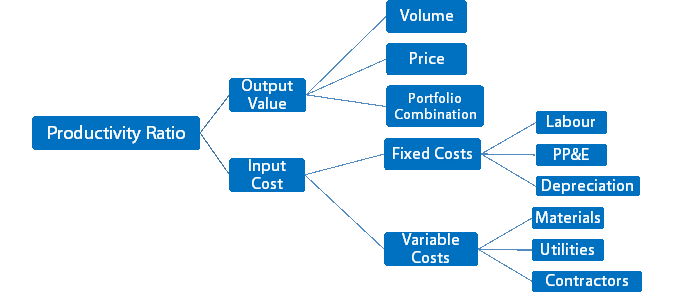Improving Productivity To Gain Competitive Advantage
In today’s competitive market, businesses understand that adopting measures to boost productivity can have a direct impact on the bottom line. In this scenario, it becomes crucial to understand ways to improve productivity in order to gain a competitive advantage.
Productivity in simple terms can be measured as output value divided by total input cost. Pursuing productivity means improving one of two variables in the equation: output value or the input costs (Exhibit 1). A sustainable competitive advantage will be the result of management’s decision as to which of the two variables they focus on: the numerator or the denominator. In order to be successful, a company must be able to differentiate itself and truly excel by picking the right levers.
Factors Influencing Productivity
Calculations for productivity can be tedious – factors such as opportunity cost, cost of labor, cost of time and others need to be considered. However, the most rudimentary calculation is just as relevant where the basic definition adds value to the way we work.
Healthcare Productivity Example
The company designs and manufactures medical devices. Most of the suppliers are domestic. The company produces specialized medical devices with very limited volumes of about 1,000 total machines per year. All the medical devices are manufactured in house. Broadly speaking, the input costs are driven by five areas:
- Assembly (Labour costs)
- Manufacturing (Production costs)
- Domestic suppliers (Raw materials costs)
- Delivery to healthcare facilities (Distribution costs)
- Improvement of design (R&D costs)
The CEO and board want to keep the company in the specialized medical devices space. They have defined the positioning of medical devices as such. The management team must maintain this position but has quite a lot of autonomy in how to proceed with production.
At the highest level, an organization is either trying to raise productivity by competing primarily by raising output value or lowering input costs. While they will pursue a combination of both, only one lever is the goal that cannot be compromised.

For this example, the company is clearly competing on the output value side. They incur steep costs to design and produce a machine that sells for the highest possible output value. That is not to say they ignore input costs, but it is not their point of differentiation. If they must spend more on R&D and manufacture the device, they will do it provided the return is very high as evidenced in the sales price and margin.
The author of this blog – Chiran Sodhi is a consultant at Trindent Consulting.




 English
English







